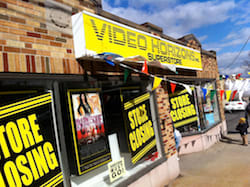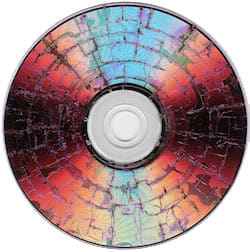Has Streaming Killed Physical Media Yet?
The decline of physical media has been a tough pill for the movie industry to swallow, but is it really so bad?
 Credit:
Credit:
Products are chosen independently by our editors. Purchases made through our links may earn us a commission.
Perhaps in 20 years, groups of the trendiest people will gather around whatever big-screen technology is dominating the market and insert a DVD into an old machine. “It... it just looks better,” the home theater owner will remark to his guests, as he toys with the signal converter box that accommodates the old component video cables.
“Mmm,” the nodding crowd will murmur.
“I prefer the VHS tape,” a dissenter might declare. “I don’t like scene skipping. You start a movie at the beginning and go to the end. It's the way the director meant for you to see it.”
From a dark corner of the room, someone will scoff. “You ever see a LaserDisc?”
Nobody aside from the nostalgia fiends over at BuzzFeed will ever have this conversation, but like music before it, video on physical media seems destined for cult status. Since sales peaked in 2007, DVDs have been in steady decline as video-on-demand (VOD) services including Netflix, iTunes, Hulu, and Amazon claw market share away from discs, tapes, and other physical formats.
This is a tough pill for the film industry to swallow. But the death of physical media—or at least its demotion to niche or cult status—will be longer and more drawn out than reports suggest.
Reports of Its Demise Are Greatly Exaggerated

The forecast for physical media is certainly cloudy. According to a report from the research firm SNL Kagan, DVD wholesale revenue fell from around $8 billion to $4.5 billion between 2009 and 2010, a drop of 43.9 percent. That's obviously bad news.
But Blu-ray discs are hanging on to relevance. As physical media’s latest tourniquet, they're stemming the losses caused by the hemmorhaging of DVD sales. They're also filling a gap while streaming video providers find ways to get 1080p content out to viewers (it requires tremendous bandwidth).
Another lifeboat for the physical media market is the popularity of TV on DVD and Blu-ray. Clearly, TV shows are a better value in terms of minutes-per-dollar than movies. A copy of The Hangover on Blu-ray, which has a 108-minute runtime, costs about $12 at Amazon—a return of 9 minutes per dollar. A season of "Deadwood," at 720 minutes, costs $22, or 33 minutes per dollar. But that's not the only consideration: "Deadwood," and many of the other "prestige" shows created by premium movie channels, aren't available via the more mainstream video streaming services. If you don't have a HBO subscription, your legal options to view those shows are only by buying the discs or downloading them from iTunes—no streaming here.
Taking all these factors into consideration, the prognosis isn’t quite as dire as SNL Kagan's DVD sales figures indicate. The consumer video retail market as a whole only declined by 10.8% in 2010, according to SNL Kagan. IBISWorld’s market research backs up SNL's findings, reporting a mere 10.4% decline from 2007 to 2012. This isn’t quite the clean bill of health the industry might have hoped for, but there are plenty of signs that the physical media market is just slowly deflating, not bursting.
Suits in the Way

Even in the face of global economic woes, the American film industry has set record after box-office record, confirming the public’s hunger for its products. But perhaps unsurprisingly, even in the face of unprecedented box-office revenue, the decline of physical media hasn’t been well received by Hollywood suits.
The industry seems to be crippled with anxiety over future media distribution models; despite the public's enthusiasm for streaming, the studios still treat it as an afterthought. The infrastructure for on-demand streaming is comparably cheap, readily available, and far more convenient for the users who already have it. So why hasn’t it already replaced everything?
The barrier to change and progress seems to be the industry itself rather than any technological barrier. Hollywood is known for ruthlessness and cunning (best personified by living caricature Harvey Weinstein), and it isn't letting physical media fade away without a fight. Ever wonder why you can't watch the Twilight movies on Netflix? Distributors are purposely keeping their best films away from video streaming services to boost physical and digital sales figures. And as Netflix's influence grows, the distributors charge them more to continue streaming the titles that they already have.
As Indiewire has reported, fear of the unknown is to blame for Hollywood's timid adoption of video on demand. Since there's hardly any data available on VOD viewership, any move towards the VOD model is a step into the unknown. In a piece for PaidContent.org, Daniel Frankel noted that many in the industry are waiting for VOD to evolve before they throw their lot in, and that the reluctance in sharing data is because there's no established context for interpreting viewing figures. There's no Nielsen ratings equivalent for streaming, and the data that does exist is independent of any benchmark. Everyone is waiting for everyone else to be the first.
Those in power are reluctant to change because it threatens their influence. But the “if it ain’t broke, why fix it?" mentality that keeps the industry on physical media’s sinking ship has hurt smaller, independent films. Most indie flicks can’t obtain a wide release, perpetually boxed out of multiplexes by studio pictures. Today, many independent studios are combining VOD and limited-theater releases to maximize profit, finding as many viewers as possible. It’s a model that has worked for films like the recent dark comedy Bachelorette, which according to the L.A. Times made more than 10 times as much in VOD sales as it did in theater receipts during simultaneous release.
Ch-Ch-Changes
We find ourselves in a transitional period. As Netflix continues to chew up market share and video rental stores blink out of existence one by one, the dinosaurs of the film industry need to get real, cut their losses, and embrace VOD. If they're lucky, the success of Netflix and its ilk will put a damper on widespread piracy, too—why put in the time and risk for illegal downloads when everything you could want is instantaneously available at a nominal fee?
Surely this changing of the guard is bittersweet. When we entertain guests, how will they know who we are if they can’t browse our DVD collections as we furtively eye their reactions? And that fanboy world of Clerks, High Fidelity, and Empire Records will be consigned to the dustbin of history, just another chapter in the ongoing saga of American culture. Still, while I know that crowd-sourced opinions will never match the sage guidance of the video rental store guru, the benefit of effortless access to some of the finest products of contemporary and classic culture is too great for the paper levees of sentimentality. The art of the world is at your fingertips.
_Photos via Jonathan Rees Wikipedia, Kosboot, and Wikimedia Commons
